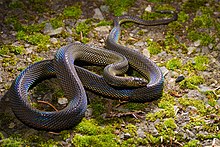Achalinus formosanus
| Achalinus formosanus | |
|---|---|
 |
|
| Achalinus formosanus formosanus | |
| Scientific classification | |
| Kingdom: | Animalia |
| Phylum: | Chordata |
| Class: | Reptilia |
| Order: | Squamata |
| Suborder: | Serpentes |
| Family: | Xenodermatidae |
| Genus: | Achalinus |
| Species: | A. formosanus |
| Binomial name | |
|
Achalinus formosanus Boulenger, 1908 |
|
 |
|
| Synonyms | |
|
Achalinopsis sauteri Steindachner, 1913 |
|
Achalinopsis sauteri Steindachner, 1913
Achalinus formosanus, common name Formosan odd-scaled snake or Taiwan burrowing snake, is a non-venomous snake in family Xenodermatidae that is found in Taiwan and in the southern Ryukyu Islands (Japan).
There are two subspecies:
Specific name formosanus means "from Formosa", referring to the fact that this species was first described from a specimen from Taiwan.chigirai refers to Yoshinori Chigira, who collected the first specimen of Achalinus formosanus chigirai.
Achalinus formosanus formosanus is ecologically and morphologically similar to the Taiwan endemic Achalinus niger; the two differ in some scale counts and characteristics. A study using genetic markers found these two taxa to be overlapping, warranting further studies on their taxonomy.
Achalinus formosanus formosanus is known from central and southern Taiwan at elevations of 1,000–2,000 m (3,300–6,600 ft) asl.Achalinus formosanus chigirai occurs at low altitudes (below 200 m (660 ft)) on the Iriomote-jima and Ishigaki Islands, both belonging to the Yaeyama Group.
Achalinus formosanus is a small snake growing to a total length of about 90 cm (35 in). The whole body is iridescent under light. Head is small, oval, and without distinct neck. Body is slender and tail is moderately short. Eyes are small, bead-like; iris is black and indistinct. Upper head, body and tail is uniform olive, grayish tan, or black. Mid-dorsal row of scales on body and tail show a dark longitudinal line. Ventral surface is olive-yellow or dark gray. The young are usually black.
It is a nocturnal, terrestrial snake that probably preys on earthworms, slugs, and frogs. It is non-venomous and not aggressive. It is oviparous.
...
Wikipedia

